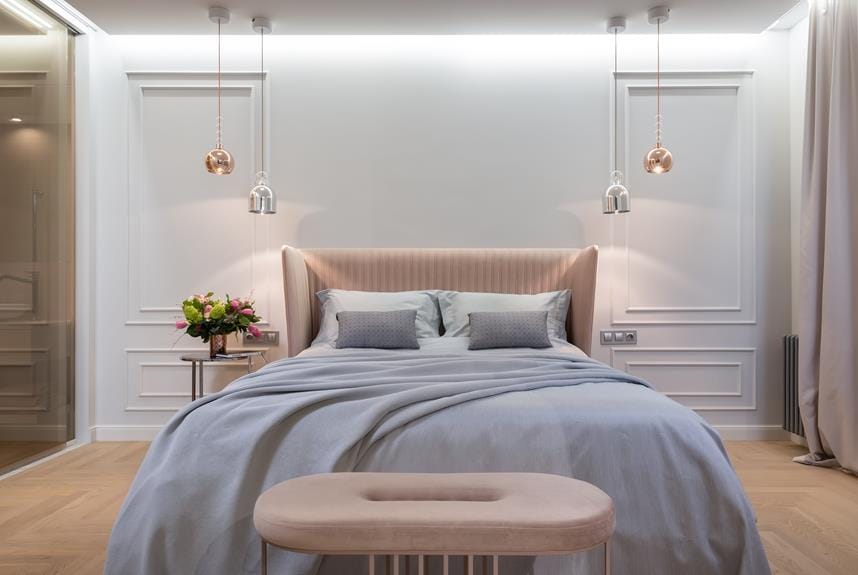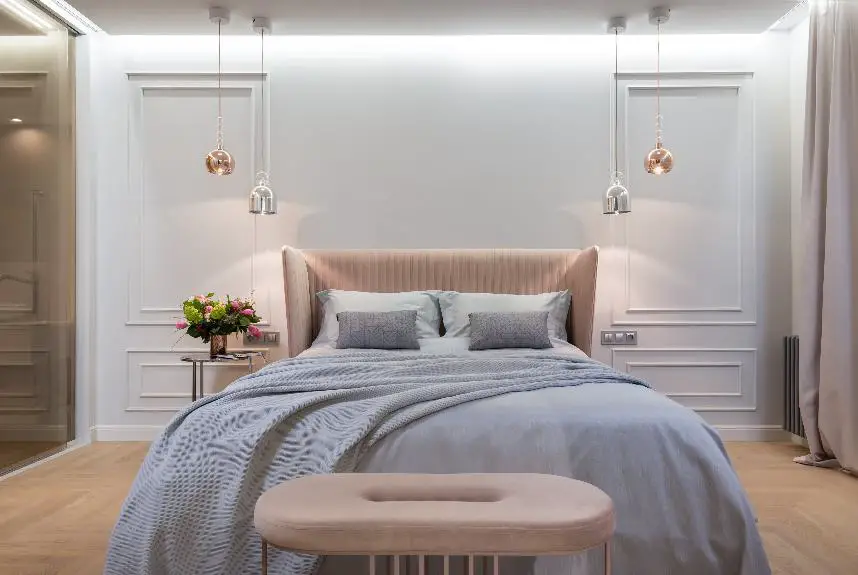To create an accent wall in a small bedroom, first choose the best wall to serve as the room's focal point. This will help make the space appear larger.
Select a color, pattern, or texture that stands out from the rest of the decor but still complements it. Using a darker or cooler color can make the wall seem further away, adding depth to the room. Patterns can create visual interest, and materials like wood or stone add texture and a sense of warmth.
By carefully combining these elements, you can turn a plain wall into a feature that enhances the bedroom's look and feel.
Assessing Your Space
The architectural layout and size of a small bedroom affect the choice of an accent wall. An accent wall can make a small bedroom seem larger and more welcoming. It's important to consider the room's size when selecting an accent wall to improve the space's feel without highlighting its smallness.
In a small bedroom, an accent wall with cool or dark colors like greens, blues, and purples can create the illusion of more space. It's important to evaluate the natural light, layout, and distinctive features of the room. Typically, the wall behind the headboard is the focus, and accentuating it can add depth.
In a narrow bedroom, choosing an accent wall requires caution to prevent a tunnel-like feel. Accenting a shorter wall can make the room feel more balanced. If the bedroom has slanted walls or other unique features, highlighting them can add charm and give the illusion of height, making the room seem larger.
Choosing the Right Wall
Choosing an accent wall in a small bedroom involves careful consideration of the room's layout. Commonly, the wall behind the bed is chosen to highlight the bed as the main feature. In small rooms, it is important to select the color of the accent wall carefully. A dark color can give an impression of depth but should be balanced with lighter colors on remaining walls to keep the room from feeling too small. Using wood for the accent wall can provide texture and warmth but must fit the room's color scheme.
For narrow bedrooms, accenting a short wall can make the room appear wider. Choosing a long wall for dark colors or bold patterns may result in the room feeling narrower. It is often recommended to select a wall with distinctive architectural features, such as one without windows or doors, or with unique shapes like alcoves.
An accent wall can include the ceiling or other features for a distinctive look. The aim is to choose a wall that enhances both the room's design and the sense of space.
Selecting Colors and Patterns
Choosing the right colors and patterns is crucial for enhancing a small bedroom. Cool and dark tones for an accent wall can make the space seem larger, while warm or light colors can add a sense of coziness, which may be better for larger rooms.
When using a dark color for an accent wall, it should be balanced with lighter colors elsewhere to prevent the room from feeling too heavy. A dark accent wall can add sophistication and contrast, but it needs to be integrated with the bedroom's color scheme.
For adding personality, patterned wallpaper with geometric designs can serve as a focal point and modernize the room. The pattern should be harmonious and not too overpowering to avoid a cluttered look.
Incorporating textures like brick, wood, or stone on an accent wall can also enhance the room's dimension and create a unique look. The accent wall should reflect personal style and complement the bedroom's size and intended atmosphere.
Incorporating Texture and Materials
Using innovative materials can change a small bedroom's accent wall into a standout feature, adding depth and personality. An architectural accent wall becomes the room's centerpiece and can reduce the need for more decorations. For example, reclaimed wood or board and batten add a tactile quality and contrast with the smoothness of wood floors, making the room feel warm, cozy, and welcoming.
A brick accent wall provides a strong, urban feel, even in traditional spaces. The brick texture is visually engaging but not overpowering in a small area. Stone veneers can also be used to create a rustic or elegant look, depending on the stone type.
Experimenting with different options allows for creativity in wall decor. Wall panels with fabric or grasscloth not only add a sophisticated texture but also help to soundproof the room for a quieter atmosphere.
To successfully integrate textures and materials into an accent wall in a small bedroom, it's important to keep a balance. The wall should complement the room's design without making it seem overcrowded. The right choice of texture and materials can make the bedroom look bigger and more luxurious.
Finishing Touches and Decor
After selecting materials and textures for an accent wall in a small bedroom, add finishing touches and decor to enhance the feature while maintaining the room's overall style. Choose art or mirrors that match the accent wall but are appropriately sized to avoid making the space feel too crowded or empty.
To ensure a unified look, use colors from the accent wall for other items in the room, such as throw pillows or a rug. This creates a cohesive atmosphere.
For practicality, use wall-mounted lights to save space and emphasize the accent wall, and install floating shelves for storage without taking up floor space. Decor should be both aesthetically pleasing and functional, particularly in small bedrooms where space is at a premium.
The decor should enhance, not overpower, the accent wall. By selecting decor thoughtfully, the accent wall will stand out, and the room will appear balanced, welcoming, and larger than it is.





